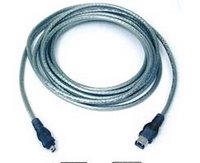Data Cables
Here is a good source of frustration for non-techies. I hope I don't confuse you further. In the end it's all about pushing around bits of data. Different connection types are used to capitalize on their features. Most things that Children's Ministers will connect to a computer will be either USB (Universal Serial Bus) or FireWire. FireWire must be a low life of some sort because it has many aliases including i.Link (Sony) and IEEE 1394, the original committee specification name.
USB
 USB, which stand for Universal Serial Bus, comes in two flavors; 1) Version 1.0 and 2) Version 2.0. The distinction between the two is typically only made for version 2.0. Version 1.0 is just referred to as USB. All new computers have version 2.0 as standard connectors. They look exactly the same. Luckily Windows added a feature that let's you know when you plugged a Version 2.0 device into a Version 1.0 connector. It will give you a little warning that the newly connected device could perform faster blah blah blah.
USB, which stand for Universal Serial Bus, comes in two flavors; 1) Version 1.0 and 2) Version 2.0. The distinction between the two is typically only made for version 2.0. Version 1.0 is just referred to as USB. All new computers have version 2.0 as standard connectors. They look exactly the same. Luckily Windows added a feature that let's you know when you plugged a Version 2.0 device into a Version 1.0 connector. It will give you a little warning that the newly connected device could perform faster blah blah blah.USB 1.0 had a data rate of 12 Megabits per second. It seemed pretty speedy at the time. Version 2.0 came along and offered 488 Megabits per second. In fact there are now three data rates for USB. The lowest is used for Keyboards and mice. The second is the old USB 1.0 standard. Finally, the high speed version mentioned above. This is the enabler to allow connection to external hard drives and downloading pictures from your camera. USB is now the most common type of connector on most PC and Macs alike.
USB hubs are small boxes that allow you to connect more USB devices than the number of connectors your computer could originally handle. Think of it as one of those devices you use to turn your electrical outlet in three. Most hubs require their own power source. This means you'll need another electrical outlet.
FireWire
 This is an IEEE specification from the 1980's. It was revived and renewed in the 90's and ultimately released by Apple in 1995. This version contains 6 pins. The Sony version or i.Link contains only four pins. The two pins lost by Sony were to provide power. The nice feature of FireWire is its data rate or how fast it can push bit down the wire to your computer. It can do this at a rate of 488 Megabits per second. This was by far the leader and the only way to go for digital video until USB 2.0 came out.
This is an IEEE specification from the 1980's. It was revived and renewed in the 90's and ultimately released by Apple in 1995. This version contains 6 pins. The Sony version or i.Link contains only four pins. The two pins lost by Sony were to provide power. The nice feature of FireWire is its data rate or how fast it can push bit down the wire to your computer. It can do this at a rate of 488 Megabits per second. This was by far the leader and the only way to go for digital video until USB 2.0 came out.A typical use of FireWire by you would be to connect a camcorder or external hard drive to your computer. The camcorder end of the cable is quite small and usually only contains four pins. The end you connect to a computer or external hard drive is much larger and is shaped like a rectangle with a triangle on the short end end.


0 Comments:
Post a Comment
<< Home